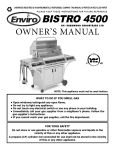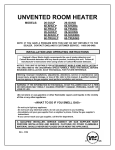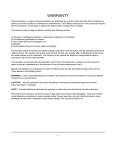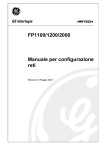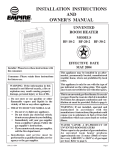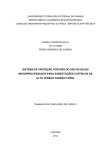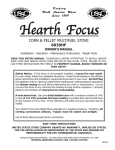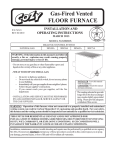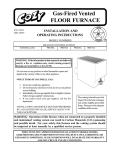Download England's Stove Works 26-GBVLP Troubleshooting guide
Transcript
INSTALLATION & OPERATION MANUAL VENTED MODELS: NOTE: 26-GBVLP 60-SHBVLP 60-TRBVLP 26-GBVNG 60-SHBVNG 60-TRBVNG IF YOU HAVE A PROBLEM WITH THIS UNIT DO NOT RETURN IT TO THE DEALER. CONTACT CUSTOMER SERVICE @ 1-800-245-6489. Save These Instructions Questions? Need Parts or Options? www.englanderstoves.com Please Note the Following Precautionary Statements: NOTE: THIS UNIT IS NOT A DIRECT VENT STOVE AND THEREFORE REQUIRES 4” B-VENT GAS PIPE WITH ONE INCH (1”) CLEARANCE TO COMBUSTIBLES. THIS STOVE IS NOT APPROVED FOR MOBILE HOME OR DOUBLEWIDE INSTALLATION. DO NOT INSTALL THIS UNIT IN A BEDROOM. England’s Stove Works highly recommends the use of smoke detectors and Carbon Monoxide detectors with any hearth product, including this unit. Follow all manufacturer’s instructions when using smoke or Carbon Monoxide detectors. WARNING: READ THIS MANUAL PRIOR TO INSTALLATION OF THE UNIT. IF THE INFORMATION IN THIS MANUAL IS NOT FOLLOWED EXACTLY, A FIRE OR EXPLOSION MAY RESULT CAUSING PROPERTY DAMAGE, PERSONAL INJURY OR LOSS OF LIFE. REFER TO AND SAVE THIS MANUAL. CONSULT A QUALIFIED INSTALLER, SERVICE AGENCY OR YOUR GAS COMPANY BEFORE INSTALLATION. WHAT TO DO IF YOU SMELL GAS •DO NOT TRY TO LIGHT ANY APPLIANCE. OPEN ALL WINDOWS AND EXTINGUISH ANY OPEN FLAME. DO NOT TOUCH ANY ELECTRICAL SWITCH. DO NOT USE THE TELEPHONE IN YOUR BUILDING - CALL THE GAS COMPANY FROM A NEIGHBOR’S HOUSE AND FOLLOW THE GAS COMPANY’S INSTRUCTIONS. IF YOU CANNOT REACH THE GAS COMPANY, CALL THE FIRE DEPARTMENT. WARNING: DO NOT STORE OR USE GASOLINE OR ANY OTHER FLAMMABLE MATERIAL IN THE VICINITY OF THIS OR ANY OTHER HEATING APPLIANCE. Rev. 5/06 A letter from our Technical Support department: Thank you for purchasing this fine product from England’s Stove Works! England's Stove Works was started, and is still owned by, a family that believes strongly in a "Do It Yourself" spirit – that’s one reason you found this product at your favorite “Do It Yourself” store. We intentionally design and build our stoves so that any homeowner can maintain his or her unit with basic tools, and we're always more than happy to show you how to do the job as easily and as inexpensively as possible. From our free, downloadable service sheets; to our Pellet Service Video; to our new "wizard-style," click-through Troubleshooting guide on our web site, we have always tried to help our customers stay "heat-ready," especially when oil and electricity prices continue to skyrocket. Please look at our vast Help section on our web site and call our Customer Service department at (800) 245-6489 if you need any help with your unit. We are nearly always able to help “walk you through” any repairs, problems or questions you may have. PLEASE NOTE: While information obtained on our web site and through our 800 number is always free of charge, there will be a service charge incurred with any “on-site” repairs or maintenance that we may arrange. Wishing you years of efficient, quality and “comfy” heating, England’s Stove Works Technical Support Department www.englanderstoves.com (800) 245-6489 IF YOU HAVE A PROBLEM WITH THIS UNIT DO NOT RETURN IT TO THE DEALER. CONTACT CUSTOMER SERVICE at 1 (800) 245-6489. SAFETY PRECAUTIONS THIS VENTED GAS FIREPLACE HEATER MUST BE INSTALLED, REPAIRED AND INSPECTED ANNUALLY BY QUALIFIED SERVICE PERSONNEL. IT IS ALSO RECOMMENDED THAT IT BE INSPECTED BEFORE USE. MORE FREQUENT CLEANING MAY BE REQUIRED DUE TO EXCESSIVE LINT FROM CARPETING AND BEDDING TYPE MATERIAL. IT IS IMPERATIVE THAT THE CONTROL COMPARTMENTS, BURNERS AND CIRCULATING AIR PASSAGEWAYS BE KEPT CLEAN; FAILURE TO PROPERLY INSTALL, ADJUST AND MAINTAIN THIS APPLIANCE MAY RESULT IN AN UNSAFE OR HAZARDOUS CONDITION WHICH MAY LEAD TO CARBON MONOXIDE POISONING, FIRE, EXPLOSION, PERSONAL INJURY AND LOSS OF LIFE. DO NOT USE THIS APPLIANCE IF ANY PART HAS BEEN UNDER WATER. IMMEDIATELY CALL A QUALIFIED SERVICE PERSON TO INSPECT THE APPLIANCE AND TO REPLACE ANY PART OF THE CONTROL SYSTEM THAT HAS BEEN UNDER WATER. ALWAYS CHECK YOUR BUILDING CODES PRIOR TO INSTALLATION. THIS INSTALLATION MUST COMPLY WITH ALL LOCAL, REGIONAL, STATE AND NATIONAL CODES AND REGULATIONS. THIS UNIT IS DESIGNED TO BURN EITHER NATURAL GAS (NG MODEL) OR LIQUID PROPANE (LP MODEL) GAS AND IS MADE TO ORDER; THERE IS NO CONVERSION KIT AVAILABLE. NEVER BURN PAPER, WOOD OR ANY OTHER MATERIAL IN THIS UNIT. NEVER LEAVE CHILDREN UNATTENDED WHEN THERE IS A FIRE IN THE HEATER. NEVER USE GASOLINE, KEROSENE, CHARCOAL LIGHTER FLUID OR ANY OTHER LIQUID FUEL IN THIS UNIT. DO NOT STORE GASOLINE OR OTHER FLAMMABLE MATERIALS IN THE VICINITY OF THIS HEATER. THIS VENTED GAS FIREPLACE HEATER MUST BE ELECTRICALLY CONNECTED AND GROUNDED IN ACCORDANCE WITH LOCAL CODES OR, IN THE ABSENCE OF LOCAL CODES, WITH THE CURRENT EDITION NFPA 70-NATIONAL ELECTRIC CODE OR CSA C22.1-CANADIAN ELECTRICAL CODE. WHILE SERVICING THIS UNIT, ALL ELECTRICITY AND GAS SHOULD BE COMPLETELY SHUT OFF. ALWAYS BE SURE THE STOVE IS COMPLETELY COOLED DOWN PRIOR TO DOING ANY TYPE OF SERVICE WORK. THIS STOVE HAS A STANDING PILOT LIGHT THAT IS LIT USING A PIEZO ELECTRIC SPARK GENERATOR AS DESCRIBED IN OTHER PARTS OF THIS MANUAL. NEVER ATTEMPT TO LIGHT THE PILOT OR MAIN BURNER WITH A MATCH OR LIGHTER. IF THE PILOT FAILS TO LIGHT AFTER REPEATED ATTEMPTS, DISCONTINUE OPERATION, TURN OFF THE GAS AT THE VALVE AND CONTACT A QUALIFIED SERVICE PERSON. THIS UNIT IS EQUIPPED WITH DECORATIVE CERAMIC FIBER LOGS. IF THEIR DECORATIVE FIBER BECOMES DAMAGED, THEY MUST BE REPLACED WITH SIMILAR CERAMIC LOGS FROM THE MANUFACTURER. DO NOT REPLACE THE MANUFACTURER-SUPPLIED LOGS WITH UNAPPROVED LOGS, REAL WOOD LOGS OR ANY OTHER MATERIAL. THIS UNIT REQUIRES AN ADEQUATE SUPPLY OF AIR TO PROVIDE VENTILATION AROUND THE UNIT AND TO SUPPORT COMBUSTION. MOST BUILDINGS HAVE SUFFICIENT AIR INFILTRATION TO SATISFY THESE REQUIREMENTS; IN SOME INSTANCES, EXTREMELY AIRTIGHT STRUCTURES MAY REQUIRE THE INTRODUCTION OF OUTSIDE AIR TO ALLOW FOR PROPER OPERATION OF THE STOVE. REFER TO LOCAL, MUNICIPAL AND NATIONAL INSTALLATION CODES. DO NOT OBSTRUCT THE FLOW OF VENTILATION OR COMBUSTION AIR, AND DO NOT PLACE CLOTHING OR FLAMMABLE MATERIAL NEAR THE HEATING UNIT. ANY SHIELD, DOOR, SAFETY SCREEN OR COMPONENT REMOVED FOR SERVICING THIS HEATER MUST BE REPLACED PRIOR TO OPERATION OF THE UNIT. IF YOU THINK THE HEATER IS NOT OPERATING PROPERLY DISCONTINUE THE OPERATION AND CONTACT A QUALIFIED SERVICE PERSON FOR INSPECTION OF THE UNIT. England’s Stove Works highly recommends the use of smoke detectors and Carbon Monoxide detectors with any hearth product, including this unit. Follow all manufacturer’s instructions when using smoke or Carbon Monoxide detectors. LISTING AND CODE APPROVALS THIS VENTED GAS FIREPLACE HEATER HAS BEEN TESTED FOR COMPLIANCE WITH THE ANSI STANDARD Z21.88-2002 AND THE CANADIAN CSA 2.33-M02 STANDARDS. THIS UNIT IS LISTED WITH INTERTEK TESTING SERVICES (WARNOCK HERSEY, INC.) OF MIDDLETON, WISCONSIN. ALL COMPONENTS ARE AGA, CGA, UL OR CSA APPROVED. THIS APPLIANCE MUST BE INSTALLED IN ACCORDANCE WITH LOCAL CODES, IF ANY; IF NOT, FOLLOW ANSI Z223.1 (NFPA 54), CURRENT EDITION IN THE U.S. OR CAN1-B149, CURRENT EDITION INSTALLATION CODE IN CANADA. NOTE: SEE LABEL ON THE VALVE FOR GAS PRESSURE TESTING LOCATION. Performance Summary Table Characteristic LP Gas Natural Gas Fuel requirement Input rating (0-610m) Minimum input (0-610m) Input rating (610 – 1370m) Orifice size (0-610m) Max. inlet pressure Min. inlet pressure Max. manifold pressure Min. manifold pressure Max. efficiency, with fan Max. output (0-610m) Gas consumption (std. cond.) Fuel supply line Flue exit Chimney spec. Ignition Actual weight Shipping weight LP Gas 33,200 BTU/HR 18,600 BTU/HR 30,200 BTU/HR #51 DMS 13.5” W.C. (3.36 kPa) 11.0” W.C. (2.74 kPa) 10.0” W.C. (2.49 kPa) 3.7” W.C. (0.92 kPa) 81.7% 27,300 BTU/HR 13.3 Cu. Ft/hr or 0.4 gal/hr. ½ inch (13 mm) 4” Diameter (Top or Rear) Type B-1 (4” Dia.) Piezo electric & pilot 161 lbs. 185 lbs. Natural Gas 32,000 BTU/HR 22,500 BTU/HR 29,300 BTU/HR #33 DMS 10.5” W.C. (2.61 kPa) 4.5” W.C. (1.12 kPa) 3.5” W.C. (0.87 kPa) 0.9” W.C. (0.22 kPa) 77.9% 25,400 BTU/HR 32 Cu. Ft/hr ½ inch (13mm) 4” Diameter (Top or Rear) Type B-1 (4” Dia.) Piezo electric & pilot 161 lbs. 185 lbs. SECTION I: FLUE SYSTEM FOR VENTED GAS FIREPLACE HEATER A. Installation of a New System (See Installation Drawings at the end of this Manual) This vented gas fireplace heater must be connected to four-inch (4”) diameter Type B-1 gas pipe. This product is manufactured and certified to NFPA 54 and NFPA 211 “current edition” standards. The minimum clearance of this pipe to combustible materials is one inch (1”). Never use aluminum or galvanized steel pipe with this unit. Single wall pipe may be used between the stove and ceiling or stove and wall; a minimum of six inches (6”) clearance to combustible materials is required for this type of pipe. It is imperative that the single wall pipe be terminated at the ceiling or wall, by connecting to a double wall B-1 Vent Pipe. Single wall pipe should never pass through a combustible wall or ceiling. Follow the pipe manufacturer’s instructions for venting through a combustible area. Installation requirements for single wall pipe or Type B-1 Vent Pipe are specified in the ANSI Z223.1 or CAN1-B149 Standard “current edition.” These standards will also indicate proper clearances to combustibles. Your stove dealer or qualified service person will be familiar with these standards and can properly install the chimney system. Connection of the pipe to the stove is accomplished by placing the pipe over the collar on the top or rear of the unit; then secure the connection with a screw through the pipe. Type B-1 Vent Pipe is designed for installation within a building -- it is not intended for outside use unless it is enclosed in a protective structure and insulated. The requirement for this is clearly stated in the Venting Tables, Category 1 – Central Furnaces, AGA and GAMA “current edition” for U.S. Installations and Standards for Gas Vents; National Standards of Canada and CAN/CGAB149.1-M91 for installations in Canada “current edition”. Condensation of exhaust gases may occur and liquid may run down your chimney if the pipe is not enclosed and insulated. The flue blockage sensor will also shut the unit down if the stove is not exhausting properly. B. Existing Flue System This stove may be connected to an existing pre-fabricated chimney or masonry chimney as long as the B-1 Vent Pipe passes through the entire length of the chimney. In cases where it is not possible to use rigid pipe, the four-inch (4”) flex pipe can be substituted. A qualified service person is best suited for properly retrofitting your existing flue system for use with a gas product. This vented gas fireplace heater must not be connected to a chimney serving a separate solid fuel-burning appliance. SECTION II: UNIT PREPARATION AND PRE-INSTALLATION A. Unit Preparation Note: We recommend using a handcart when unloading and placing this stove. Never attempt to handle this unit without help. When your unit arrives, it should first be uncrated. Remove all packing material outside the stove and from the interior of the firebox, and open the firebox by unscrewing the bolt on the right side of the doorframe. Remove the inflated air bag, instruction manual and wall thermostat from the interior of the stove. Note: Do not remove the ceramic logs. If you do so by mistake, follow the guidelines below for proper placement of the logs. B. Log Placement The logs are in the proper position when the unit leaves the plant. However, during the shipping of the unit the assembly can become misarranged. Check to be sure the logs are still located in the provided slot behind the front portion of the burner tube and the rear of the assembly is touching the firewall. The front log should be straight up or perpendicular to the floor. Contact the factory at 1-800-245-6489 if you see a cracked or broken log. C. Top or Rear Vent Your stove comes with the option of venting out of the top or rear of the unit. The stove must be set up for the desired venting direction prior to operating the unit. First, remove the two screws that hold the grilled top onto the stove. They are located on the back of the stove near the top. For the top exit installation, place the flue collar on the top of the stove and fasten it with the four (4) bolts, nuts and washers. Install the flue cover plate on the rear opening of the unit using the supplied bolts, nuts and washers. Next, find the vent safety shut-off switch inside the draft hood on the back of the stove. It is the small disc-shaped object screwed to an L-shaped bracket; there are two (2) sets of holes on this bracket. Position this vent safety shut-off switch as far up in the flue as possible, or in a direction heading toward the ceiling. This is accomplished when the lower set of holes in the bracket is aligned with the two holes in the back of the stove. For the rear exit method, place the flue collar on the rear of the stove and fasten it with the four (4) bolts, nuts and washers. Install the flue cover plate on the top of the unit with the supplied bolts, nuts and washers. Next, find the vent safety shut-off switch inside the draft hood on the back of the stove. It is the small disc-shaped object screwed to an L-shaped bracket; there are two (2) sets of holes on this bracket. Position the vent safety shut-off switch so the switch is as far down in the flue as possible, or in a position closest to the floor. This is accomplished when the upper set of holes on the bracket is aligned with the two holes in the back of the stove. D. Gas Pressure The input rate of this vented gas fireplace heater is 33,200 BTU/HR with liquid propane and 32,000 BTU/HR with natural gas. The supply gas pressures are listed in the manual under the LISTING AND CODE APPROVALS and outlined under the “Performance Summary Table” listed earlier. The gas supply line should be ½” in diameter with ½” male NPT for connection to the stove. This connection point is found on the lower rear portion of the heater. It is also helpful to install a 1/8” NPT plugged tap at the inlet to the stove for checking the inlet gas pressure. In addition, it would be useful to add a manual gas shutoff at the inlet to the stove. The inlet gas pressure to the stove should be adjusted in accordance with the guidelines stated in the “Performance Summary Table.” The vented gas fireplace heater and its individual shutoff valve must be disconnected from the gas supply piping system during any pressure testing of that system at test pressures in excess of ½ PSIG (3.5 kPa). E. High Altitude Installation For Canadian installations, this stove is certified for elevations from 0 – 2000 feet (0-610m) above sea level. For Canadian installations above 610 – 1370 meters, the orifice size for natural gas is #35 DMS, and for liquid propane the size is #52 DMS per CAN/CGA 2.17 tests, “current edition.” For high altitude installations, consult the local gas distributor or the authority having jurisdiction for proper rating methods. If the installer must convert the unit to adjust for varying altitudes, the information sticker must be filled out and adhered to the appliance at the time of conversion. (Sample Sticker:) →This appliance has been converted for use at an altitude of _____________________ Orifice size ___________________ Manifold Pressure ___________________ Input (Btu/HR) __________________ Fuel Type ___________________ Conversion Date ________________ Converted by ___________________ At the higher altitudes, gas codes make it necessary to decrease the amount of gas input. This decrease in gas flow is accomplished by using an orifice of the correct size. The input should be reduced by four percent (4%) for each 1000 feet above sea level — a qualified gas service person can determine the correct burner orifice. The unit is shipped with a #51 DMS orifice for LP and a #33 orifice for natural gas. All installation aspects of this stove must conform to the national fuel gas “listing and code” ANSI Z223.1/NFPA 54 or CAN1-B149 “current edition.” SECTION III: WALL AND FLOOR PROTECTION A. Heater Location and Wall Protection This freestanding stove is a high efficiency unit, which means it gives off a great deal of heat. For this reason, the unit should not be located in a traffic area or near drapes or curtains, which present a fire hazard. It is important to allow for adequate clearance between the stove and the nearest combustible; the unit must be at least three inches (3”) from a rear wall and twelve inches (12”) from a combustible sidewall. B. Floor Protection This stove may be installed on a hard combustible surface such as a wood floor, and it may also be installed on noncombustible surfaces such as brick, marble or slate. Floor protection will be required if this unit is placed on a combustible material other than wood. SECTION IV: FREESTANDING HOOK-UP A. Chimney Connector The chimney connector must be four inch (4”) diameter single wall pipe or Type B-1 Vent Pipe. If a single wall pipe is selected as a chimney connector, it should only be used between the stove and the ceiling or the stove and the wall. A single wall pipe must be terminated at the ceiling or wall and changed to type B-1 pipe and used with the proper wall or ceiling pass-through kits. Do not use aluminum or galvanized steel pipe, as neither is designed for use with your gas heater. Never use single wall pipe as a chimney; you must connect your stove to a chimney comparable to those listed earlier in this manual. The flue connector pipe must be installed on the stove so it goes outside the flue collar. In Appropriate Clearances for other words, after the chimney connector pipe is Vented Gas Unit Installation installed, the pipe will completely cover the flue collar. The pipe will be marked with arrows, and all pipe should be installed with these pointing up or away from the unit. These are called “direction of flow markings” and should be oriented properly. (See Installation Drawings at the end of this Manual.) B. Thermostat Your stove comes supplied with a wall thermostat that controls the temperature of the unit and room. This thermostat is compatible with the low voltage electrical system (0.75 volt or 750 millivolts) of your stove. If you decide not to use the thermostat supplied with the stove, be sure to use one that is compatible with the operation of a “millivolt” system. When planning your stove location, be sure to consider the thermostat. The thermostat should not be located more than twenty feet (20’) from the stove and should be at a height of at least five feet (5’) above the floor. It is recommended that insulated 18-gauge wire be used to achieve optimal performance (ten feet of wire is furnished with the thermostat). If the thermostat has to be placed farther away from the stove, it is recommended that a larger gauge wire be used. It is a good idea to leave some extra wire behind the stove so the unit can be moved out for cleaning. Mount the thermostat level for proper operation, and follow the manufacturer’s directions for installing this part. SECTION V: BLOWER The blower is standard on your vented gas fireplace heater and provides 100 CFM of circulating air capability – it operates on 115 volts AC, 60 HZ power source and draws 1.5 AMPS. The blower is attached to the rear of the stove with four (4) screws. Blower activation is achieved with a temperature switch that mounts to the back of the firebox. When the back wall of the stove heats up, the blower will activate and when it cools down, the blower will automatically shut off. The blower will activate at the speed as set on the variable speed dial. SECTION VI: OPERATING INSTRUCTIONS WARNING Children and adults should be alerted to the hazards of high surface temperatures of the appliance and should stay away to avoid burns or ignition of clothing. Young children should be carefully supervised when they are in the same room as the appliance. CAUTION •If the door is removed for service it must be replaced prior to operating this appliance. •Clothing or other flammable material should not be placed on or near the appliance. •Before operating this heater, please review the safety precautions given earlier in the manual. •Check the logs for proper location. •Check for gas leaks – soap and water can be used to expose suspected leaks. •Verify that the connector pipe and chimney is unobstructed. •Be sure the door is properly sealed. •When installing the blower, check all connections to avoid electrical shock. •Open the gas valve access door to get to the valve; this will also expose the instructions. FOR YOUR SAFETY READ BEFORE LIGHTING WARNING: If you do not follow these instructions exactly, a fire or explosion may result causing property damage, personal injury or loss of life. 1. This appliance is equipped with a manual piezoelectric ignition device. Do not try to light the pilot by hand. 2. Before lighting, smell around the appliance area for gas. Be sure to smell next to the floor because some gas is heavier than air and will settle on the floor. 3. Use only your hand to turn the gas valve control knob. Never use tools. If the knob will not turn by hand, do not try to repair it, but call a qualified service technician. Force or attempt to repair may result in fire or explosion. 4. Do not use this appliance if any part has been under water. Immediately call a qualified service technician to inspect the appliance and to replace any part of the control system and any gas valve control that has been under water. WHAT TO DO IF YOU SMELL GAS: • • • • • Do not try to light any appliance. Do not touch any electric switch; do not use any phone in your building. Immediately call your gas supplier from a neighbor’s telephone. Follow the gas supplier’s instructions. If you cannot reach your gas supplier, call the fire department. LIGHTING INSTRUCTIONS 1. STOP! Read “For Your Safety” above. 2. Set the thermostat to lowest setting. 3. Turn off all electric power to the appliance. 4. This appliance is equipped with a manual piezoelectric ignition device. Do not attempt to light the pilot by hand. 5. Turn gas valve control knob fully clockwise → to “OFF.” 9. Push in the gas valve control knob and hold it in while pushing the button of the piezoignitor. Push the piezoignitor button several times while holding the gas valve control knob in. 10. After the pilot has ignited, you may cease pushing the piezoignitor button. Continue to hold the gas valve control knob for approximately 30-60 seconds. Release the gas valve control knob and it will “pop” out. If the knob does not pop up when released, stop and immediately call your service technician or gas supplier. The pilot is now lit. 11. For the very first lighting, it may take several attempts to purge air from the gas line. If pilot ignition does not occur or the pilot goes out, repeat steps 9 and 10. 12. Turn the gas valve control knob fully counterclockwise ← to “ON.” 6. Wait five (5) minutes to clear out any gas. If you then smell gas, STOP! Follow the “For Your Safety Read Before Lighting” information earlier. If you do not smell gas, go to the next step. 7. Be sure the thermostat is set at the lowest setting. 8. Turn the gas valve control counterclockwise ← to “PILOT.” knob 13. Turn on all power to appliance. 14. Set thermostat to desired setting. 15. If the appliance will not operate, follow the instructions “TO TURN OFF GAS TO APPLIANCE” and call your service technician or gas supplier. 16. Shut the gas valve access door. TO TURN OFF GAS TO APPLIANCE 1. Set the thermostat to lowest setting. 3. Turn gas valve control knob fully clockwise → to “OFF.” Do not force. 2. Turn off all electric power to the appliance if service is to be performed. 4. Shut gas valve access door. 1. White Rogers Pilot Light Assembly (located in the firebox) 2. Spill Switch (located in the draft hood beneath the flue collar) 3. Wall Thermostat 4. Piezoelectric Spark Ignitor (located near the gas control valve) Blower and Valve/Thermostat Wiring Diagrams for this Unit Blower Wiring Valve/Thermostat Wiring SECTION VII: FIRST FIRE HINTS YOU SHOULD KNOW A. Lighting the Pilot Some additional pointers or guidelines about lighting the pilot may be helpful. First time ignition should be done by a qualified service person. This technician has the knowledge to trouble shoot the system and adjust the pilot light if required. Purging the air out of the gas line is also a common problem that could require repeated attempts to light the pilot. Once the pilot is burning, by looking from the front of the stove you can see a flame -- this small, yellow tipped, blue flame should be visible when the main burner is not operating. When the main burner is on, it is evident from the larger visible flame in the firebox. The main burner will now respond to the thermostat setting. Pilot Flame Size Firebox Flame Size B. Smoke and Odor There will be some visible smoke and some odors coming from the stove with the first few fires. These are caused by the burning of binders from the logs and brick fiberboard, oils from the manufacturing process and curing of the painted surface of the stove. This “off-gassing” will cease after a few fires; however, it is a good idea to open some windows and doors in your dwelling during this time. While this “off-gassing” is occurring, the brick fiberboard will turn a dark color. This is only a temporary effect, and it should return to the original color after a few fires. In the beginning, the flames will be taller than normal, and may even hit the top inside of the stove. The binder in the logs and brick fiberboard acts as fuel, and can make the flame burn higher. This will correct itself after a few fires and the flame should stabilize at a height of no more than 85% of the front glass window. C. Glass Windows This unit is manufactured with high temperature ceramic glass, and substitute materials should not be used. This stove should not be operated if the glass is cracked, broken or removed. The glass/frame assembly shall be replaced as a complete unit as supplied by the manufacturer. The replacement of the glass should done by a licensed or qualified service person. This stove has a middle and two side glasses that mount inside the door frame. The glass can be changed by removing the window bracket that is located in the bottom inside of the door frame. The bracket can be removed by raising it up and removing it through the small channel located on the lower left side of the door frame. The new glass with gasket can then be placed in the proper space and the channel snapped back into place. The replacement glass is designed for our units only and can be ordered by calling (Parts Orders Only: 1-800-516-3636). When the stove is first started, the glass will fog up with condensation from the combustion process. The condensation will evaporate and disappear as the glass and stove reach full operating temperature, which will usually take two to three minutes. If you happen to see a grey film or haze forming on the inside of the glass, it should be removed immediately; this could be from the logs not being located properly and too much flame hitting them. The haze can be removed in the early stages, but is permanent if left on too long. The logs should be all the way to the back and left inside the stove. WARNING: DO NOT USE ABRASIVE CLEANERS. ALLOW THE UNIT TO COOL DOWN BEFORE CLEANING THE GLASS. DO NOT ABUSE THE GLASS BY SLAMMING THE DOOR OR STRIKING THE GLASS. D. Valve and Burner Controls 1) Variable Heat Input Controls On the gas valve, to the left of the green or black gas control valve knob is another control. This is the variable heat input control that continually varies the gas going into the stove from low to high. The high setting allows the maximum amount of gas to enter your stove, and is used for cold winter nights or when you desire to heat a larger space; the low setting may be used during the spring and fall months when not as much heat is required. The low setting gives approximately 50% of the heat as compared to the high setting. 2) Air Shutter Adjustment on the Burner Tube The air shutter is an adjustment on the burner tube. Its purpose is to control the amount of air that enters the burner tube. In concept, opening the shutter permits more air to enter the tube and causes the flames on the main burner to be bluer and burn cleaner. Closing the shutter has the opposite effect, and causes the flame to burn orange and dirtier. Note: Only a qualified service technician should make Air Shutter adjustments. E. Seasonal Shut-down At the end of the season, the stove should be shutdown completely, which will conserve gas and save you money. First, move the thermostat control or lever to the “OFF” position. Then, shut off the gas to the main burner by turning the gas valve control knob fully clockwise → to the “OFF” position. F. Lighting the Heater During Regular Use Simply turn up the switch on the wall thermostat to the desired temperature. If the thermostat temperature is greater than the room temperature, the heater will come on immediately. If the thermostat temperature is less than the room temperature, the main burner will not come on until the temperature falls below the thermostat setting. G. Shut-down During Regular Use Move the thermostat switch to the “OFF” position. Please note while the thermostat is in this position the pilot light still remains on, but the unit will not light. SECTION VIII: MAINTENANCE A On a routine basis check around, beside, behind and under your vented gas fireplace heater to be sure that no combustible material has been placed close to it. Items like paper bags, newspapers, dust, clothing, liquids with flammable vapors, flammable liquids and all other combustibles should be kept away from the heater. B. Keep the main burner, burner ports, pilot and valve clean of metal flakes from minor corrosion (carbon or any other foreign material) that may occur from the high temperatures. Turn the thermostat and gas valve to the “OFF” position before any cleaning procedure. Note: Let the unit cool down to room temperature before cleaning! It is recommended that you use a clean, dry paintbrush to clean the interior of the stove and a vacuum cleaner to remove the carbon from the logs. The glass in the door may be cleaned with a glass cleaner, but we advise never to use an abrasive cleaner for this operation. C. Check the venting system at the beginning and the end of each heating season to be sure it is connected properly and no blockages have occurred. A qualified technician should do this. REPLACEMENT PARTS DESCRIPTION Front Glass Side Glass 4” Blank Flange 4” Flue Collar Front Door Flue Blockage Switch Thermopile Pilot Orifice Burner Orifice Gas Valve Pilot Burner Large Window Brass Trim Small Window Brass Trim (2) Front Log Middle Log Back Log Left Log Right Log Thermostat Remote Thermostat PART NUMBER AC-G14 AC-G13 CA-3029 CA-3031 GU-GBVD GU-60T11 GU-214212 GU-F69-2064(LP only) GU-F69-20631(NG only) GU-LP051 (LP only) GU-NG033 (NG only) GU-3LCLP (LP only) GU-4LCNG (NG only) GU-EDI-701 GU-3025 AC-106-G AC-106-GB GU-4801 GU-4802 GU-4803 GU-4804 GU-4805 GU-1E30-914 AC-3001 Note: All replacement parts can be ordered from your local dealer or from the factory at (Parts Orders Only) 1-800-516-3636. If you have any questions or problems contact the Customer Service Department. [email protected] CUSTOMER SERVICE DEPARTMENT P.O. BOX 206 Parts Orders Only: (800-516-3636) MONROE, VA 24574 Questions/Help: (800-245-6489) (FAX: 434-929-4810) Trouble Shooting Guide Warning: To avoid electrical shock, always disconnect the unit before attempting any trouble shooting procedures (unless otherwise indicated in this manual). If the solution in this guide does not correct the problem, consult your local dealer or call the factory. “Caution: Label all wires prior to disconnection when servicing controls. Wiring errors can cause improper and dangerous operation” and “Verify proper operation after servicing.” Problem Cause Solution 1. Pilot doesn’t light. Gas not on. Piezo ignitor not sparking. Misaligned Piezo ignitor. Air in the lines. Turn gas on. Check for spark w/door closed. Adjust spark to be 1/8” to hood. Bleed air from line. 2. Pilot doesn’t stay lit. The thermopile’s not fully surrounded by the flame. Wiring is loose in system. Defective thermopile. Adjust the thermopile so the flame directly impinges upon it. Tighten any loose wires. Replace thermopile. 3. No ignition to burner. Gas is off. Pilot is off. Thermostat is set too low. Thermostat is defective. Turn on gas. Light by instructions. Move to higher setting. Connect the 2 thermostat wires together. If the unit lights, the thermostat is bad – replace it. 4. Carbon deposits on Logs not in properly. Incorrect burner orifice. Air shutter out of adjustment. High altitude, check orifice. See “Log Placement” in manual. Compare size as in table. Open air shutter slightly. Match orifice to altitude. 5. Glass fogs up. Normal for 2 to 3 minutes. No action required. 6. Blue flames. Normal for first 20 minutes. No action required. 7. Repeated on, off cycle. Heat shutting off thermostat. Flue blockage sensor. Move farther from unit. Check flue for blockage or downdraft. 8. Unsatisfactory burn. Gas pressure incorrect. Contact local gas supplier. logs, glass or burner. Installation Drawings – Through-the-Ceiling and Through-the-Wall Note: When running double-walled pipe up the side of home, you must build a chase around the chimney pipe. Have this information on hand if you telephone the factory or your dealer regarding this product. (Retain for your files) Model Number __________________________________ Date of Purchase ________________________________ Date of Manufacture ____________________ Serial #__________________________ LIMITED 5 YEAR WARRANTY FROM THE DATE OF PURCHASE TO THE ORIGINAL OWNER The manufacturer extends the following warranties: 1. Carbon steel and welded seams in the firebox are covered for 5 years against extreme warpage and welded seams from splitting. 2. The burner, valve, tubes and glass are warranted for 1 year. 3. Electrical components such as the blower and thermostat are warranted for 1 year. This warranty does not apply if damage occurs because of an accident, improper handling, improper operation, improper installation, shipping damage, abuse, or unauthorized repair made or attempted to be made. Purchaser must give notice of claim of defect within the warranty period and pay any transportation expense to and from a service center designated by the factory for service. The dealer from whom the stove was purchased or the factory will perform warranty service at our option. 4. All liability for any consequential damages for breach of any written or implied warranty is disclaimed and excluded there from. Some states do not allow the exclusion or limitations of consequential damages, so the above may not apply to you. This warranty gives you specific legal rights, and you may also have other rights that vary from state to state. THIS WARRANTY IS NULL AND VOID IF YOU DO NOT RETURN THE ATTACHED WARRANTY SHEET WITHIN 30 DAYS FROM THE DATE OF PURCHASE. WARRANTY IS NOT TRANSFERABLE WARRANTY REGISTRATION for England’s Stove Works Purchased by (Name) ______________________________________________ Address _________________________________________________________ City ________________________ State __________ Zip _________________ Telephone _______________________________________________________ Email Address ____________________________________________________ DEALER INFORMATION Purchased From (Dealer) ___________________________________________ Address _________________________________________________________ City ________________________ State __________ Zip _________________ UNIT INFORMATION (Please be sure to refer to sticker on back of manual or box to complete this section) Model Number _____________________ Purchase Date _________________ Purchase Price ____________________ Serial Number _____________________ Mfg. Date ______________________ How did you first hear about our product? (please check one) ___ Word of Mouth ___ Burn Trailer Demonstration ___ Internet Other: ____________________________________________________ Where did you receive information about our product? (please check one) ___ Rec’d. info. via phone ___ Dealer (Name of dealer): ______________________ ___ Internet Other: _________________________________________________ IMPORTANT NOTICE THIS REGISTRATION INFORMATION MUST BE ON FILE FOR THIS WARRANTY TO BE VALID. PLEASE MAIL THIS INFORMATION WITHIN THIRTY (30) DAYS FROM THE DATE OF PURCHASE. Mail To: England’s Stove Works, Inc. Customer Service Department P.O. Box 206 Monroe, VA 24574 Or, Fax To: (434) 929-4810 – 24 hours a day Or, now available – Go online to complete your Warranty Registration! Visit www.englanderstoves.com if you prefer to register online.

















